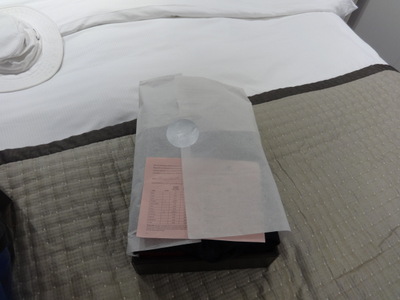
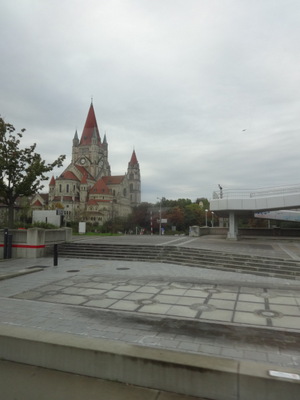 Very busy day today, making up for yesterdays quiet one, with excursions morning, afternoon, and evening. I was disappointed not to find Canary melon on the breakfast buffet—it never reappeared.
Very busy day today, making up for yesterdays quiet one, with excursions morning, afternoon, and evening. I was disappointed not to find Canary melon on the breakfast buffet—it never reappeared.Saturday, 1 October, Vienna, Austria (panoramic, Lippizans, and Heurigen dinner)
Written 21 January 2023 (bet you thought I was never going to get back to this project; sometimes I wondered myself)

 Very busy day today, making up for yesterdays quiet one, with excursions morning, afternoon, and evening. I was disappointed not to find Canary melon on the breakfast buffet—it never reappeared.
Very busy day today, making up for yesterdays quiet one, with excursions morning, afternoon, and evening. I was disappointed not to find Canary melon on the breakfast buffet—it never reappeared.
But back in my stateroom after breakfast, I found my clean laundry waiting for me. You just put the stuff you want washed in the bag they provide, fill out the little order form, and leave it all on your bed. After breakfast the next day, it reappears neatly folded in this handsome little wooden box, loosely wrapped in tissue paper, and sealed with a Viking logo seal. The cost goes on your shipboard account, which you settle at the end. I'm always a little puzzled about filling out the form, since some of the terminology is not the same in the U.S. and Europe. E.g., in Germany, does "slip" mean what an American would call a slip or the entirely different garment the French call a slip? And when you indicate what service is desired—wash and iron or just iron—why is the first of the two marked "not applicable" with respect to skirts and dresses?
Anyway, bright and early, we boarded the buses for our "Panoramic" tour of Vienna. And the very first sight we saw, still standing on the riverbank waiting to board, was the magnificent pile at the right, St. Francis of Assisi church. It's 125 years old (construction started in 1898) and is also called the Jubilee Church (because it was built to commemorate the 50th anniversary of the reign of Emperor Franz Joseph I) and the Mexico Church. That last name is used because it's on Mexico Square. And that name arose because Mexico is the only country that protested Austria's being annexed by the Third Reich.
We only saw it from the outside, but I'm told there's a beautiful memorial chapel inside for Empress Elizabeth—Sisi. She was the first protector of the Red Cross, so when she was stabbed to death by an assassin, also in 1898, the Red Cross and other folks raised a lot of money to build it.
Opposite the ship on an island in the Danube, are the UN's buildings in Vienna, but I never managed to get a good photo of them.
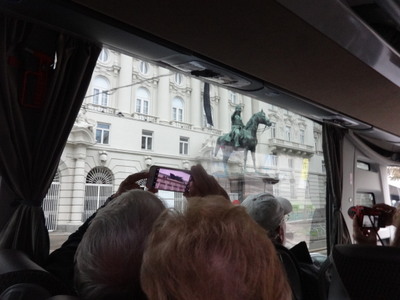
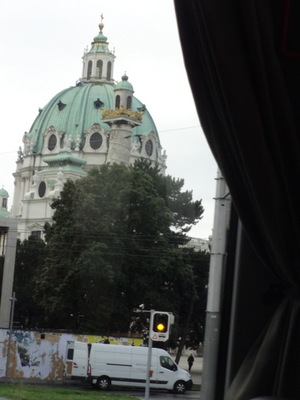 I like Viking's panoramic tours very much—you get to see a lot in a short time, hit all the high spots, and get a general orientation to the city, and our driver Adrian and guide Karl did a wonderful job and showered us with fascinating information—but their major drawback is illustrated by these two photos. On the left is a famous equestrian statue of Field Marshal Radetzky, Austria's greatest military man. It stands in front of the War Ministry (and was moved with it when the ministry changed locations in 1912). That's the best shot of it I could get from the moving bus, even though we passed it more than once. And the photo gives no idea whatever of what the War Ministry's building looks like. You're usually too close to the buildings you drive past even to get a look at the whole facade, let alone get a photo.
I like Viking's panoramic tours very much—you get to see a lot in a short time, hit all the high spots, and get a general orientation to the city, and our driver Adrian and guide Karl did a wonderful job and showered us with fascinating information—but their major drawback is illustrated by these two photos. On the left is a famous equestrian statue of Field Marshal Radetzky, Austria's greatest military man. It stands in front of the War Ministry (and was moved with it when the ministry changed locations in 1912). That's the best shot of it I could get from the moving bus, even though we passed it more than once. And the photo gives no idea whatever of what the War Ministry's building looks like. You're usually too close to the buildings you drive past even to get a look at the whole facade, let alone get a photo.
We passed by the Karlskirche (at the right), officially the Rektoratskirche St. Karl Borromäus, at a greater distance, so I was able to get the whole central dome and one of its side towers into the shot.
I love the ability conferred by the internet to look up and put names to many of the buildings and monuments I photograph, which tend to go by too fast, especially since I have no way to index my recorded notes to particular photos.
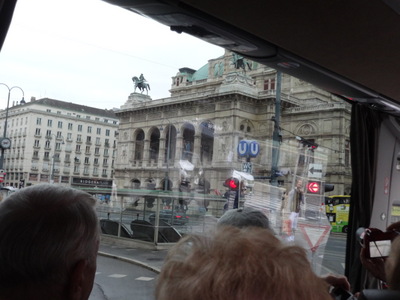
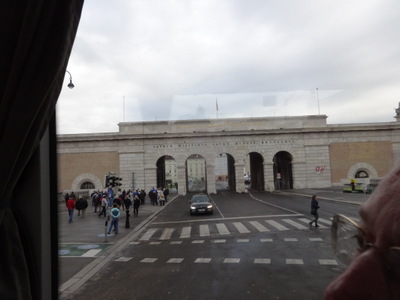 Like many cities in Europe, Vienna decided at one point (in this case in 1857) to tear down its wall and replace it with broad avenues. The result in Vienna was the Ringstrasse, and a great many large and impressive, not to say opulent, homes and public buildings were constructed along it from the 1860's to the 1890's (he younger brother of Emperor Franz Josef II had a house there). The oldest is the Vienna Opera, shown here at the left, recognizable by the bronze horsemen on the top. The Karl told us it was initially unpopular in style, to the point that both architects went into hiding before it's grand opening. In 1945 it was 80% destroyed (Vienna took many air raids during WW II, killing 7,000 people; the bombers were probably aiming elsewhere but hit the Opera), but it's been completely rebuilt. A different opera is performed every day (in rotation, I assume), and is 97% sold out.
Like many cities in Europe, Vienna decided at one point (in this case in 1857) to tear down its wall and replace it with broad avenues. The result in Vienna was the Ringstrasse, and a great many large and impressive, not to say opulent, homes and public buildings were constructed along it from the 1860's to the 1890's (he younger brother of Emperor Franz Josef II had a house there). The oldest is the Vienna Opera, shown here at the left, recognizable by the bronze horsemen on the top. The Karl told us it was initially unpopular in style, to the point that both architects went into hiding before it's grand opening. In 1945 it was 80% destroyed (Vienna took many air raids during WW II, killing 7,000 people; the bombers were probably aiming elsewhere but hit the Opera), but it's been completely rebuilt. A different opera is performed every day (in rotation, I assume), and is 97% sold out.
At the right is the gate to the Hofburg Palace (also on Ringstrasse). Only the emperor was permitted to drive through the center arch. We walked through one of the side arches later in the day, on our way to the Spanish Riding School.
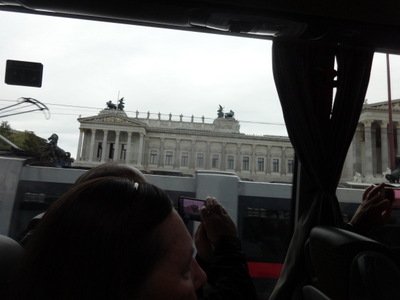
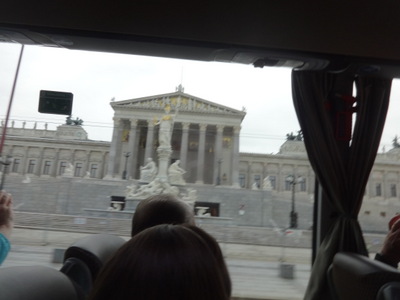 Here are one wing (at the left) and the central facade (at the right, kinda blurry) of the Parliament building. It has not just horsemen but entire bronze chariots on top. The central facade was designed to echo classical Greek temples, because Greece was the first democracy.
Here are one wing (at the left) and the central facade (at the right, kinda blurry) of the Parliament building. It has not just horsemen but entire bronze chariots on top. The central facade was designed to echo classical Greek temples, because Greece was the first democracy.
As long as they were on such a building kick along the Ringstrasse, they decided to rebuild the river, too. The Suez canal opened in 1869. The emperor, Franz Josef I, went to the opening, and he brought back the engineering team that built it to work over the Danube. Apparently, up until then, the Danube at this point was miles wide, and it took 12 bridges, hopping from island to island, to get across. The engineers dug a nice straight shipping canal across what had been a bend in the river; built Danube Island, which is 12 miles long and is where the UN buildings and other high rises are, and dug a second canal behind the island to help with flood control. It wasn't quite enough, so they've since dug a third canal, which is usually kept dry unless they need it to contain flood waters; the city is now safe from flooding.
Franz Josef I was the longest-reigning emperor they ever had. He reigned for 68 years (St. Francis was built when he hit 50) and died in 1916. He wasn't quite the last of the Hapsburg emperors; they rules for 648 years, ending in 1918.

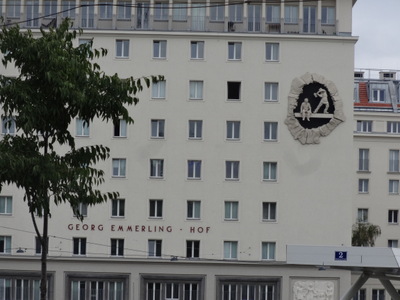 The church at the left (with one of its spires covered with scaffolding) is the Votive Church. Franz Josef narrowly escaped assassination at age 23, and his younger brother Maximillian raised the money to build that church in gratitude. Max was the one who later became emperor of Mexico and was executed there three years later.
The church at the left (with one of its spires covered with scaffolding) is the Votive Church. Franz Josef narrowly escaped assassination at age 23, and his younger brother Maximillian raised the money to build that church in gratitude. Max was the one who later became emperor of Mexico and was executed there three years later.
At the right is a municipal housing block sporting a whimsical piece of monumental art. I think it's actually three dimensional and not just trompe-l'oeuil. According to Karl, Vienna has 195 parks, and 2/3 of population lives less than 300 yards from a public park. He explained that older apartment buildings don't have balconies, so residents needed to get out to the parks. He claimed that half of Vienna is either green space or water, a third is houses (by which I think he meant buildings),and the rest is streets. It encompasses 2 horse tracks, 2 baseball fields, and a stadium or two in the Prater. The Prater (meaning "meadow") is Vienna's largest park, twice the size of New York's Central Park. It was originally the imperial hunting grounds, then public hunting grounds, and finally a public park. About 10% of it is taken up by an amusement park that includes a giant Ferris wheel, the oldest still standing (and working!) of a group of similar ones built in the 1890s. The Ferris wheel featured in the classic film The Third Man, and saw it more recently on Public TV in the mystery series Vienna Blood. Another major park is the Volksgarten. It's next to the imperial palace and was originally the private park of the emperor and didn't become public until the end of the monarchy. Across the street from it, the city's major art and natural history museums face each other across an open plaza. I didn't manage to get a photo, but we also drove by a "ship column" like the ones we saw in St. Petersburg—a tall column studded with the protruding bows and stersn of ships—topped with a statue of Admiral Wilhelm von Tegetthof, Austria's most celebrated naval man. Back when Austria was bigger and had access to both the Mediterranean and the North Sea, he fought the Italians in 1866, famously ramming and sinking three of their ships and running the rest off. We also drove by a brownish house with red flags where Johan Strauss Jr. used to live, but I didn't get a good photo. Jr. wrote about 200 waltzes, and apparently the most famous, Blue Danube, was written in that house. Although Jr. was the international star (giving concerts all over the world, including Boston and New York), his father and two brotherse were also composers. Sr.'s most famous composition is the Radetzky March (for Marshall Radetzky, mentioned above); just Google it up and listen to a few bars. You'll recognize it instantly. According to Karl, Austria's population is about 8 million. In about 4 years, Vienna's will be back up to about 2 million. It was 2.1 million at one point, but the two world wars lowered it. In 1850, Vienna was just what is now the "1st district," a circle smaller than the Ringstrasse. It had high walls, fortifications, bastions, and moats and was that way for 340 years before the walls were removed and the city expanded. Another feature we drove by that I didn't get a hoto of is the city's most-photographed monument—the gilded statue of Johan Strauss Jr. playing the violin in front of a white marble arch in the Statdtpark. I didn't realize how large it is, since we've seen a replica of it else that's only about 4 feet high.
Finally, the bus dropped us off to continue our tour on foot. At the right here is a particularly handsome drinking fountain in the street, together with a pair of our fellow cruisers. The unfortunate whitish object under its top arch is a piece of fast-food trash that someone wedged in there. The medallion under our shipmate's foot says something about the thirsty of the city; I think it means the city dedicates the fountain to them. Since 1873, the city gets its water from the high alps. The first water main to come to town powers a high-jet fountain dating to 1857. (Written 6 February 2023) Among other things we were told or shown, on the bus on or foot included: Written 8 February 2023
At the right is a handsome building with stripes of red and yellow brick. I think the guide told us what it was, but I missed it, and surprisingly, I haven't been able to figure it out despite many Google searches. Anybody have a clue?
At the right are cups, mugs, and other dishes patterned with the works of Klimt. And souvenir fridge magnets protraying all of the above. This trip made clear that the biggest-selling souvenirs in eastern (and western) Europe are fridge magnets.
At the right behind a statue of our old friend Gutenberg) is Regensburger Hof, built (if I understodd correctly) in the 14th century by the Regensburg merchants as a place for them to stay when they visited Vienna. It was renovated in 1897. It once housed the oldest coffee roastery in Vienna. At some other point, the director of Irma la Douce lived there (he was nominated for an Oscar 27 times and won 7). It was one of the nicest houses in Vienna, and Friedrich III (whose statue appears in the little niche on the front, level with Gutenberg's elbow) would rent it for state guests and parties.
Today, it houses a coffee shop called "Lugek" (which the guide said means "Look out!"), where we enjoyed a hot chocolate during our free time.
Figures march around it, from left to right, a different one at each hour (each with its own song), then all of them at once at noon. A plaque on a nearby wall identifies all the figures, which range from Emperor Marcus Aurelius (1 o'clock) through Empress Maria Theresa (11 o'clock) to Joseph Hayden (12 o'clock). Originally, a 1000-pipe organ was concealed behind the sunburst at the top, but it was ruined during WWII. Now recorded music plays instead. (At 5 pm during Advent, it plays Christmas carols.) A pointer indicates the minutes across the top, and a basilisk (part rooster and part toad) is depicted behind the gold curtain across the bottom. It was designed by Franz Matsch. Matsch formed a company with Gustav Klimt's brother, and they designed the insides of a lot of public buildings together before he became a professor and designed this clock. The guide told us that the clock runs faster or slower according to the ambient temperature, varying by as much as 12 minutes. It was running slow when we were there. From where I stood to photograph the clock, when I turned 90 The fountain survived the bombing of WWII, but all the surrounding buildings were destroyed and have been rebuilt. The guid also claimed that this square is also where the first Christmas tree in Vienna was erected when the tradition was brought from Germany.
The bishop's palace next door (Vienna has both a bishop and a cardinal) was also covered with scrim (featuring huge posters for Nivea skin cream) to conceal renovations going on behind it. The two relatively short towers flanking the main entrance were finished, but the one of the taller pair topping the transcepts was not. It's topped by a green dome only a little higher than the top of the nave. It's to the left, out of the frame in my photo, but in the right-hand photo (a bronze model of the building for the blind), you can just see it, right above the right-hand of the two lower towers. Until the 1950's the fire department kept a lookout halfway up the taller tower. The Ottomans besieged Vienna twice, and when they were repulsed the second tie, they left behind all their cannons. The Viennese used all that metal to case a huge bell. It fell from the tower when the church burned, but it was recast after the war, when the cathedral was rebuilt. The original building dates from 1137 and was actually outside the city wall, but the next expansion of the city widened the circle (to the footprint that has now been replaced with the Ring) and brought it inside. The original romanesque facade was turn down in 1263 and rebuilt, larger and more gothic. The two towers flanking it remained romanesque and are therefore called the "heathen towers." The church was in use during the contruction—they just kept the newer part walled off until it was finished, then tore down the wall and moved into the addition. It belonged to Passau, the largest bishopric in the world at the time; all the churches around here are called St. Stephan. The Parvis in front was used as a cemetery until the year 51 of some century, but I didn't catch which century. The guide assured us that Richard the Lionhaearted was held for ransom here, but I don't know whether he meant here here, in the cathedral or someplace nearby—we've also been shown a castle on the Rhine where he was held, but maybe that was a different time. To get him back, England had to pay three times its annual income, 150,000 marks (literally tons of silver), which Vienna had to share with the German emperor.
At another corner was this statue (originally the pulpit inside the church) of St. John Capistrano (who preached here) trampling a defeated Turk Meanwhile the guide continued with the symbolism of the architecture. Three is a heavenly number, like the trinity, whereas 4 is an earthly number, like the seasons or points of the compass. The windows where the rabble sat have four sections; the ones in the choir where the monks sat have three. Add them together and get 7, another holy number. The building is 111 feet wide, 333 feet long, and 444 feet tall. To get to the top is 343 steps (7 x 7 x 7). Clearly those religious architects had too much time on their hands.
At the right is a view of the giant Ferris wheel. More things we learned on the way back to the ship:
The sandwich had all the right stuff in it, but it had not been authentically pressed flat, and David found the crust a little hard to bite through. The other lunch choices were not any more authentic to the region. Even the desserts were good old American brownies and banana splits.
Here, at the right, is David with the standard Viking birthday cake—actually a thin shell of yellow cake filled with mango-passionfruit mousse and topped with a passion-fruit mirror glaze—and light, fluffy, tangy and tasty it is, too.
At the right here is a shot of the three that I got later in the day—hornrim Dave, my Dave, and Australian Dave. My Dave spoiled the pattern a little by only being 73. The other two were both 75.
On the right is an equestrian statue of Prinz Eugen (Eugene of Saxony), in front of the palace itself. If the sculptor has followed tradition, the horse's pose with two feet off the ground indicates that the prince died in battle.
In 1580 Archduke Charles of the Austro-Hungrian Empire established a stud farm and brought horses from Lipizzan, in Spain to stock it. Later, between 1729 and 1735, Emperor Charles VI built the school, and the horses have been trained there ever since, in the very same stables we visited. The whole operation is now protected as a UNESCO World Heritage site/cultural phenomenon, and it has run continuously since its founding except for a hiatus during WWII, when the horses were moved to Slovenia for safety. At the end of the war, the stock farm was directly in the path of the approaching Russians, and the director was afraid the Russians would eat the horses, so he appealed to Patton. He even took some horses along and did a performance for him. Patton was fascinated; he thought it strange that men of military age during the war spent their time "training horses to wiggle their asses," but he thought that as a 200-year-old art form, it was worth preserving, better than some old oil painting anyway. So, without asking anybody's permission, he sent some men on "Operation Cowboy" with orders to get the horses and get them out. It worked; 400 horses were rescued, ridden or driven over the border to safety in Austria. Disney made a movie about it, The Miracle of the White Stallions. After walking in through the multiarched gate I showed a photo of somewhere above, we turned right and entered the riding school through the ornate doorway in the left-hand photo. Inside, in one of a number of display cases that lined the walls of the hallway, were these lovely china figurines illustrating some of the maneuvers executed by the famous white stallions. Note that each rider is holding four reins, two on each side of the horse's neck. Each pair of reins is attached to one bar of a double bit, so that the rider can signal commands to the horse with just a twitch—or combination of movements—of the hand on one rein, the other, or both.
Each horse gets an hour in the walker each day, without a rider. And they are still sometimes walked out in the park behind the library. Of the performing stallions, 120 are at the training center in the country in lower Austria, with a paddock for each horse, pastures, and opprtunities to ride in the forest. Currently 65 are in residence here. Every 10 weeks they are traded out, so that the city horses get to go to the country. They travel by truck, about 3.5 hours.
At the right here is the central courtyard of the stables themselves. Note the large, white, winged horse suspended overhead. Under the archways at the far end (and to the sides, as well) are the double doors to the horses' loose boxes, with the top halves open. At the stud farm in the country, they produce about 250 foals a year. They breed from all the performing stallions and from some others as well who never become performers. I think they said that four or five stallions are chosen each year (in rotation) to produce all that year's foals. By the time the young horses are three and a half years old, the trainers know which ones to keep for breeding and which could become performers. The stallions are chosen for looks, character, and gait (e.g., roman nose, strong neck, 15 hands high) and are trained for both carriage and riding; they must prove they're good at both. It's traditional to use all stallions for performancesmdash;they are showier and more muscular, and it takes a lot of muscle to perform some of the maneuvers asked of them. The ones who prove unequal to the tasks are sold to good homes. (The ones we saw were not for sale.) The mares are also trained for carriage work and riding. Mares and geldings compete in carriage driving, and the mares that show all the right characteristics are used for breeding. The Lipizzan stock originally came from Spain, but a German, African, or Arabian stallion is occasionally brought in for breeding, to strengthen the line in some particular way. A Hungarian stallion is currently in residence at the stud farm. Someone asked whether a separate groups of Lipizzans is kept in the US for the shows there. No, the guide said, when you go to a Lipizzan show in North America (as we did many years ago, in Tallahassee), you're seeing horses that traveled from this facility to the US for the purpose. On the other hand, there is a large large Lipizzan population in the US; many are bred in Michigan. All those foals that don't quite make the grade physically, or who don't have the temperament to become performers, are sold off, untrained, for ca. 5000 euros each. So anyone with the money can acquire them— many of the fiacres in town are pulled by "excess" Lipizzans.
I asked whether they had trouble with the stallions wanting to fight each other. The guide replied that, no, so long as no mares are around, the stallions get along just fine. But bring a mare into the stable, and everything changes! During our questions and answers in the courtyard, the guide pointed out the two stable cats, who ensure that no rodents move in to raid the stores of fodder.
Some of the stalls are "inside cabins" and have no window to the open air. Apparently, allergies are something the breeders are always watching for and trying to breed out of the line. Horses with dust allergies are always kept in outside stalls, with access to fresh air. We also went inside and saw the stalls from the indoor side, though I don't seem to have gotten a photo of that. At the right is a view of the tack room. Each stallion has his own custom-fitted saddle—several, actually: working, performance, etc. The metal on the tack is brass, and the white performance saddle is made of white buckskin. Red saddle pads are for horses who perform only "airs on the ground," maneuvers that don't involve having all four hooves off the ground at once. Some other color marks those able to perform "airs above the ground," like the famous capriole. It takes real muscle (as well as considerable smarts) to learn to jump straight up in the air, tuck your forlegs under, and thrust your hind legs straight out behind, and some of them can even do it carrying a rider! Places on the riding staff are highly sought after. They currently have 23 riding staff at the moment, including 4 chief riders, but not all are fully trained (full training takes 10 years). On the other hand, full training for the horses takes only about 8 years. Riders must be slim and have long legs, and applications are taken only if there's an opening. The riders do all the stable work and polishing. They need not stay for their whole careers, but most want to, and they retired about age 65. The last step in training is to train a young stallion from the beginning. Each rider rides 4–5 horses, but each horse has only one rider. The riders live here but they're paid, because this is their job. The facility is owned by the Ministry of Agriculture, but it was lately partly privatized.
At the right is the Baroque arena where the horses perform on Saturdays and Sundays, unless they are "on holiday." We were allowed to look in the door (the one where the horses enter) but were asked not to step inside, as the surface had just been raked smooth. Violet, the lady from New Zealand who was part of our group, was incensed to learn that there had been a performance that morning that Viking had not mentioned to us—she would have been there even if she'd had to go by herself by taxi! The painting at the far end is of Charles VI, and when hte riders lift their hats in salute at the end of each performance, they aren't actually greeting the audience—they're thanking Charles VI for building the arena. (Charles VI was the father of Maria Theresa. The palace, only finished in the late 19th century, is on the site of a Roman fortress built in the 1st century on a Roman street that starts at the Danube and runs straight inland. It's still called Herrengasse, or street of the lords.) Lipizzans are born dark colored, and they can take up to 16 years to turn fully white, though the guide pointed out a four-year-old who was almost white. They are not shod unless they need shoes for what the guide called "orthopedic reasons." They are branded in several places, including a "P" for "Piba" (where they are born) on the hind leg, and and "L" near the mane on the left. These markings allow them to travel internationally without being chipped. They are retired after about 20 years of performing but live to be 30 (a 40-year-old just died, out at the retirement farm). Puti IV is currently being easted into retirement. Their stalls are lined with straw or wood shavings, and as needed, they are provided with heating lamps, exposure to day light, even aroma therapy. I think the guide said that each brood mare produces 40 to 50 foals, so she must be barefoot and pregnant most of the time, all of her life! And all the stallions go by girls' names because of the traditional naming convention. Each horse is named for his sire (or perhaps the line his sire came from, of which there are very few) and his dam, and because so many would have the same sire's name, they go by their dam's names, with numbers added to differentiate different horses with the same parentage. (As the guide pointed out, "Dee here is the half brother of Kitty I in the next stall.") I have no idea how the mares' names are chosen. I found the system confusing, but I'm sure it's fully explained somewhere on the web.
When the Ringstrasse opened, there were 27 coffee houses, and I think the Centrale was one of them. Anyway, in his youth, Trotsky used to hang out there before going home (some years later) to lead the revolution of 1917. Then it was back to the ship by a scenic route. As we rolled along city streets in the bus, we were for many blocks paralleling a large pipe, maybe a couple of feet in diameter, raised maybe 15 feet above the sidewalk on blue metal stanchions. Asked what it was, the guide explained that is is carrying the ground water that seeps into the excavations now under way for construction of a new subway line. The water is pumped out of the trenches and into this pipe, which carries it away to be dumped into the Danube. Vienna currently has five subway lines, numbered 1, 2, 3, 4, and 6. The new one will be number 5.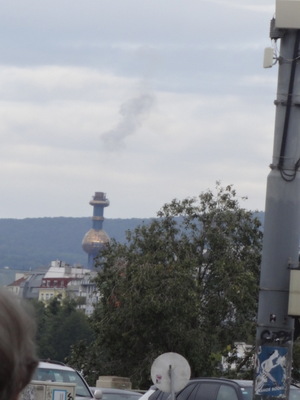
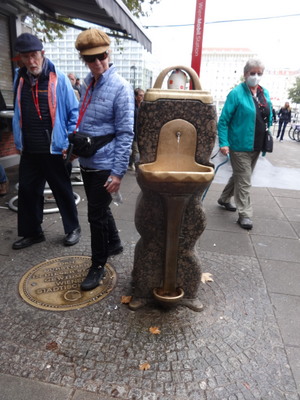 At the left here is the smoke stack of the municipal garbage incinerator. In Vienna, even that is decorated with a gilded orb and other gold trim.
At the left here is the smoke stack of the municipal garbage incinerator. In Vienna, even that is decorated with a gilded orb and other gold trim.
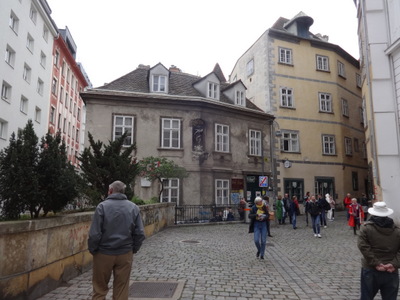
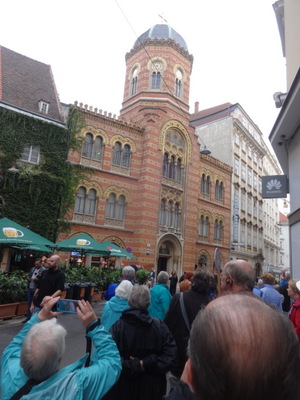 Also in the Greek quarter is the local Orthodox church, shown at the left, sandwiched between two other buildings. Its nondescript appearance and low profile have helped it survive the vicissitudes of the city's history.
Also in the Greek quarter is the local Orthodox church, shown at the left, sandwiched between two other buildings. Its nondescript appearance and low profile have helped it survive the vicissitudes of the city's history.
 Nearby, shop windows were filled with souvenirs of the city. At the left are ceramic models of the cathedral, opera, other civic buildings, carousels, and the Ferris wheel.
Nearby, shop windows were filled with souvenirs of the city. At the left are ceramic models of the cathedral, opera, other civic buildings, carousels, and the Ferris wheel.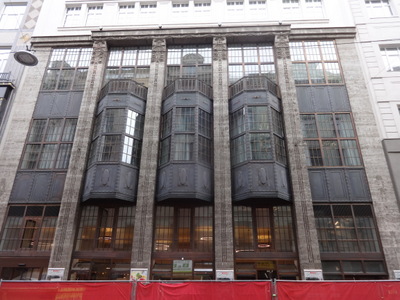
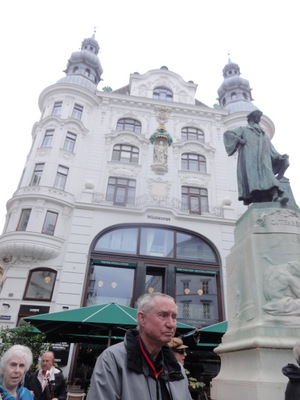 At the left here, is a façade that I had mentally labeled "jamluk," but the guide then pointed it out as an example of "Secession" architecture, from 1903.
At the left here, is a façade that I had mentally labeled "jamluk," but the guide then pointed it out as an example of "Secession" architecture, from 1903.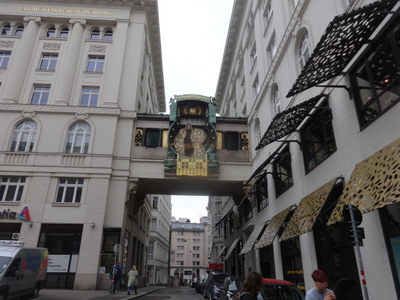
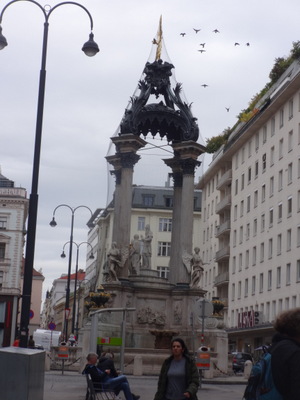 In the "high market" square, originally the center of the Roman garrison on this site, the guide showed us the elaborate Art Nouveau Anker clock. It was built by the Anker insurance company just before WWI, to emphasize that the company took care of you from birth to death.
In the "high market" square, originally the center of the Roman garrison on this site, the guide showed us the elaborate Art Nouveau Anker clock. It was built by the Anker insurance company just before WWI, to emphasize that the company took care of you from birth to death.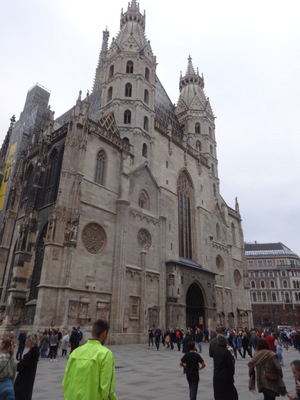
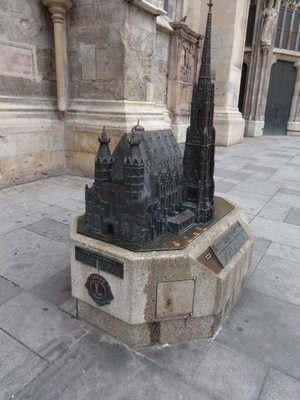 At the left here is the Stephansdom, St. Stephan's cathedral. Stephan was the first Christian martyr, stoned to death in 36 AD. The structure with a yellow poster on it is a column of scaffolding. Our guide assured us that they are always working on one part or another of the building, so there's always scaffolding somewhere.
At the left here is the Stephansdom, St. Stephan's cathedral. Stephan was the first Christian martyr, stoned to death in 36 AD. The structure with a yellow poster on it is a column of scaffolding. Our guide assured us that they are always working on one part or another of the building, so there's always scaffolding somewhere.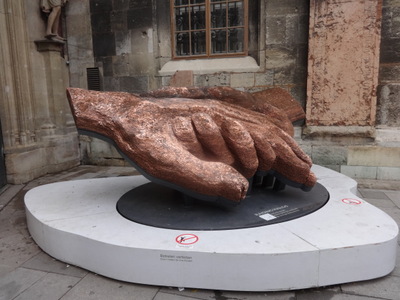
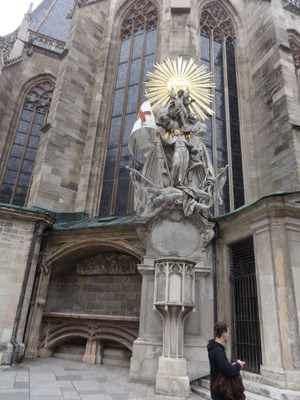 Walking around the outside, we encountered this amazing sculpture called "Raising Hands." It's a wire mesh framework entirely filled with coins, each the size, shape, and color of an American penny.
Walking around the outside, we encountered this amazing sculpture called "Raising Hands." It's a wire mesh framework entirely filled with coins, each the size, shape, and color of an American penny.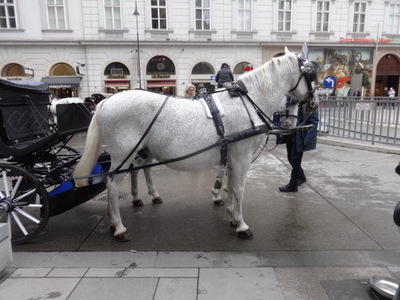
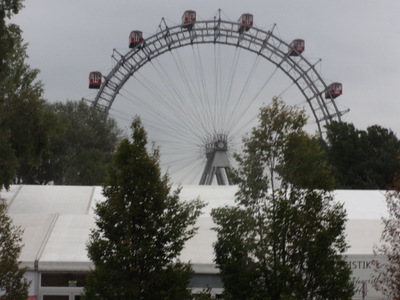 Here, at the left is one of the 163 "fiacres" still active in Vienna (there were 1000 in 1900). The name comes from the similar carriages that were just as numerous in Paris back in the day and used to congregate rue Saint-Fiacre. You can tell by the framing of the photo that I was more interested in the horse than the carriage. It's a "flea-bitten gray," just like one we had when I was a kid. The dots just look gray most of the time, but when the horse is wet, you can see that each one is actually a cluster of dots about the color of a calico cat. Many of the carriage horses in Vienna are actually Lippizans—the Spanish Riding School breeds more than it needs and sells the extras—but I don't know whether this one is.
Here, at the left is one of the 163 "fiacres" still active in Vienna (there were 1000 in 1900). The name comes from the similar carriages that were just as numerous in Paris back in the day and used to congregate rue Saint-Fiacre. You can tell by the framing of the photo that I was more interested in the horse than the carriage. It's a "flea-bitten gray," just like one we had when I was a kid. The dots just look gray most of the time, but when the horse is wet, you can see that each one is actually a cluster of dots about the color of a calico cat. Many of the carriage horses in Vienna are actually Lippizans—the Spanish Riding School breeds more than it needs and sells the extras—but I don't know whether this one is.
Whew! All that, and only time for lunch!
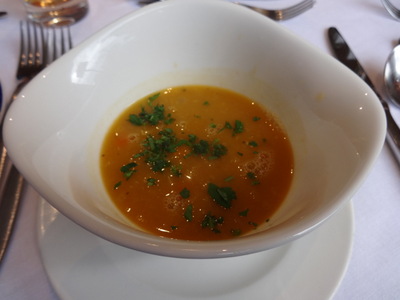
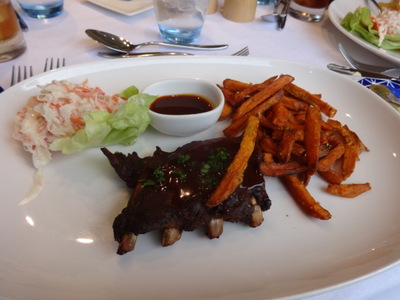 The starter was red lentil and coconut milk soup. Then I had the bbq baby back ribs with sweet potato fries, and David chose the Cuban sandwich with regular fries.
The starter was red lentil and coconut milk soup. Then I had the bbq baby back ribs with sweet potato fries, and David chose the Cuban sandwich with regular fries.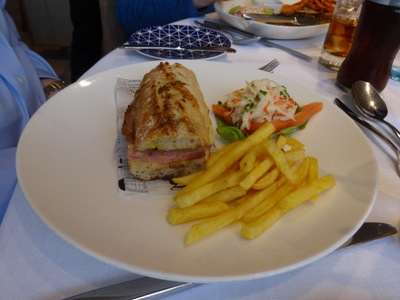
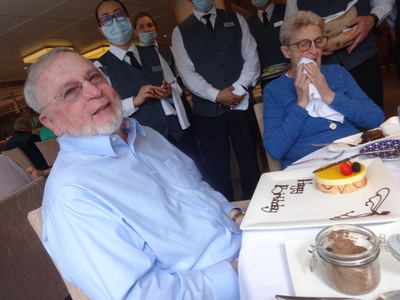 But we didn't sample the desserts, because 1 October is David's birthday! Ordinarily, the staff would have clustered around and sung to him at dinner, but because we were signed up for dinner off the ship, they had to do it at lunch instead.
But we didn't sample the desserts, because 1 October is David's birthday! Ordinarily, the staff would have clustered around and sung to him at dinner, but because we were signed up for dinner off the ship, they had to do it at lunch instead.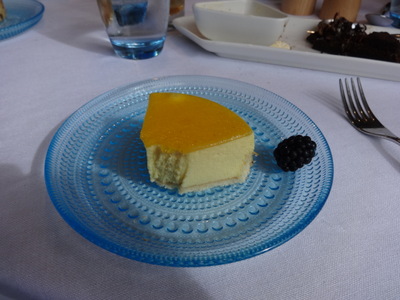
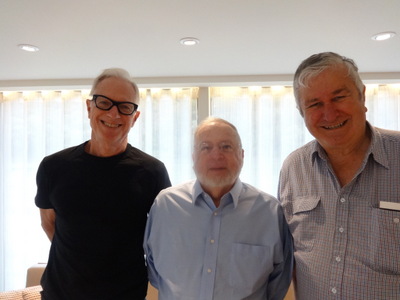 It's actually too bad we weren't going to be there for dinner, because as it happens, three guys on board had birthdays that day, and they were all named Dave!
It's actually too bad we weren't going to be there for dinner, because as it happens, three guys on board had birthdays that day, and they were all named Dave!
 Then it was back into the bus for our behind-the-scenes tour of the Spanish Riding School! On the way, I got the shot at the left of the Maria Theresa Memorial, which stands on the esplanade between the art and natural history museums across from the palace.
Then it was back into the bus for our behind-the-scenes tour of the Spanish Riding School! On the way, I got the shot at the left of the Maria Theresa Memorial, which stands on the esplanade between the art and natural history museums across from the palace.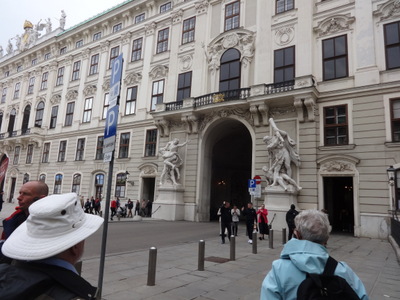
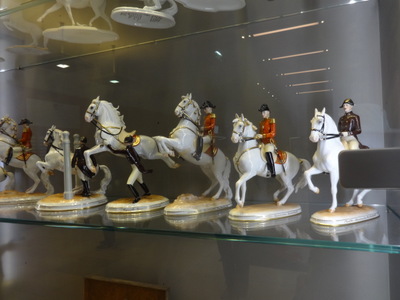 Our afternoon excursion was to the famous Spanish Riding School to see the Lipizzan stallions—we only got the behind-the-scenes tour, though, not a performance. (We did get to see some video excerpts.)
Our afternoon excursion was to the famous Spanish Riding School to see the Lipizzan stallions—we only got the behind-the-scenes tour, though, not a performance. (We did get to see some video excerpts.)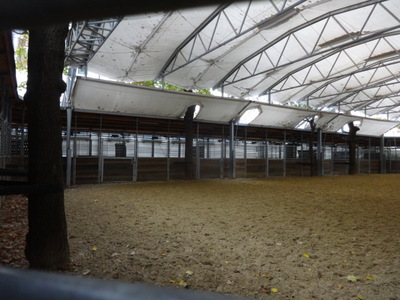
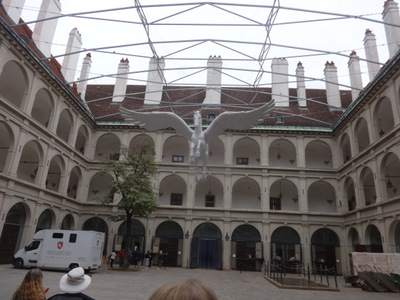 Under a canvas canopy in a large interior courtyard, we were shown the world's largest mechanical horse walker. In the photo at the left, I'm looking across the oval at the stalls on the far side. Each horse is placed in its own compartment, with curtain walls in front and in back, and the whole apparatus then turns, while the horses walk around and around for exercise. It's arranged in a long oval rather than a circle so that the horses spend most of their time walking straight rather than constantly turning.
Under a canvas canopy in a large interior courtyard, we were shown the world's largest mechanical horse walker. In the photo at the left, I'm looking across the oval at the stalls on the far side. Each horse is placed in its own compartment, with curtain walls in front and in back, and the whole apparatus then turns, while the horses walk around and around for exercise. It's arranged in a long oval rather than a circle so that the horses spend most of their time walking straight rather than constantly turning.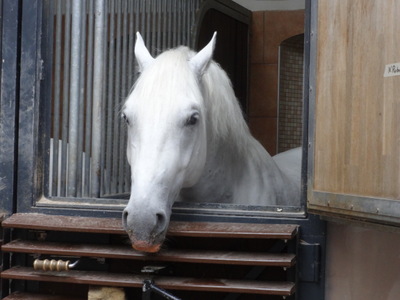
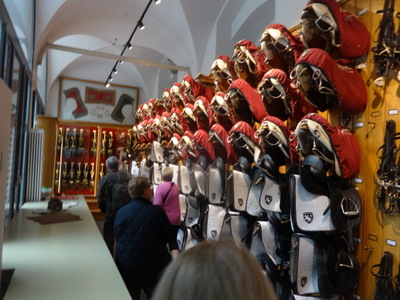 Here's one of the stallions now, looking out at us over his door. We were allowed to walk right up to them but asked not to touch them. I think this one is Croya, born in 2013.
Here's one of the stallions now, looking out at us over his door. We were allowed to walk right up to them but asked not to touch them. I think this one is Croya, born in 2013.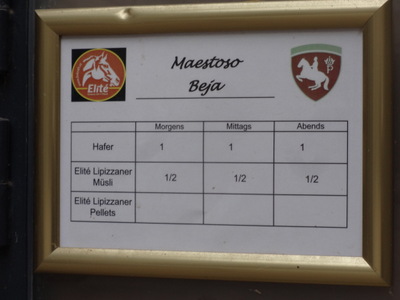
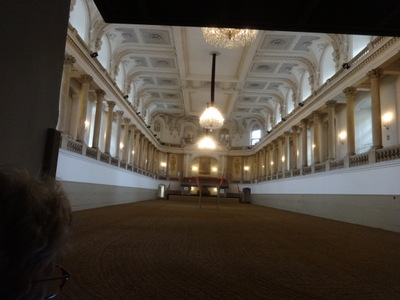 A photo I did get inside the stables is this feeding chart, which was posted on the door of the stall occupied by Maestoso Beja. All the stallions get custom diets consisting of varying amounts and proportions of three components: oats (Hafer), proprietary Lipizzaner müsli, and proprietary Lipizzaner pellets. Beja gets one measure of oats and half a measure of müsli three times a day. Other charts called for other combinations. For example, Sauve II gets only `1/3 measure morning, noon, and night and only pellets.
A photo I did get inside the stables is this feeding chart, which was posted on the door of the stall occupied by Maestoso Beja. All the stallions get custom diets consisting of varying amounts and proportions of three components: oats (Hafer), proprietary Lipizzaner müsli, and proprietary Lipizzaner pellets. Beja gets one measure of oats and half a measure of müsli three times a day. Other charts called for other combinations. For example, Sauve II gets only `1/3 measure morning, noon, and night and only pellets.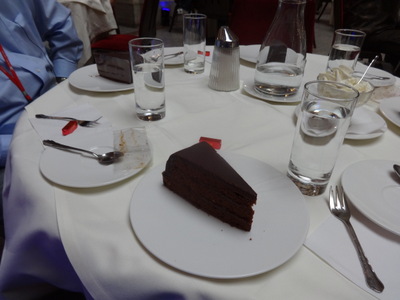
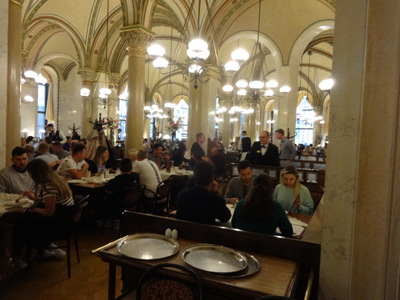 After the tour of the riding school, just in case Viking wasn't feeding us enough, we were taken to the Café Centrale for dark chocolate Sachertorte, whipped cream on the side.
After the tour of the riding school, just in case Viking wasn't feeding us enough, we were taken to the Café Centrale for dark chocolate Sachertorte, whipped cream on the side.
In the same park is a palace-like structure where the Vienna choir boys have their boarding school; over 100 of them live there. The choir was founded in 1498, and the current members live and attend school at the palace. They are divided into four choirs of 25 members each and have their own private modern concert hall on the premises.
More stuff we learned/saw/were told about:
Written 12 February 2023
We got back to the ship in time for the evening's predinner briefing. Looking out the window of my cabin, I find I'm eye-to-eye with the passing swans.
But after the briefing, it was back into the buses for the trip to our Heurigen dinner. Bobby was our driver again, and our guide was Robert.
The dinner was great. It was at a Heurigen house—a winery specializing in "new" wine, wine of the current year's production. Such dinners are popular not just with tourists but with the locals, too. The one we went to (Weinbau Wolf) has been in business (in the same family!) since 1609—they're on the 13th generation; 4 generations currently live together in the house. It produces 95% white wine and only about 5% red. Different grape varieties are planted together and then crushed together, blended right from the vinyard.
The whole affair involved much more food and much less talk than the other tastings we attended. They served five wines, sparkling water, and (at my request) still water. Each course was served family style, on platters that we passed around the tables.
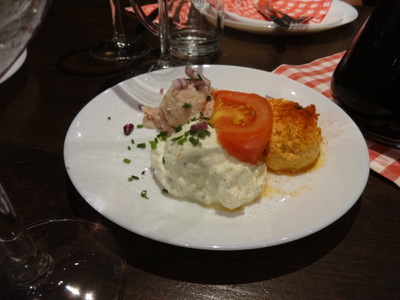
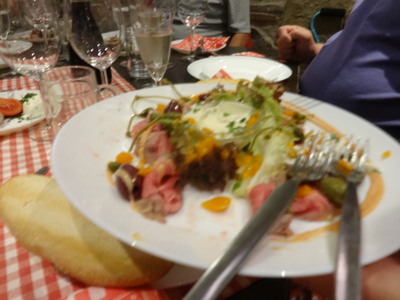 The first course was a trio of spreads to be eaten on bread—a white cheese one, an orange seasoned-cheese one, and a meat-based one, all topped with a tomato slice.
The first course was a trio of spreads to be eaten on bread—a white cheese one, an orange seasoned-cheese one, and a meat-based one, all topped with a tomato slice.
The second was a plate of thinly sliced rare roast beef surrounding a dish of sauce and garnished with olives and caper berries.
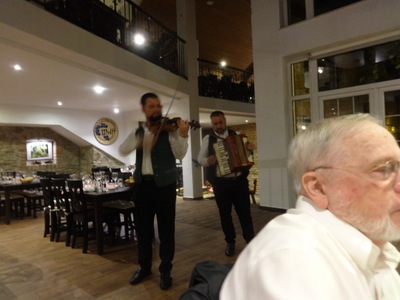
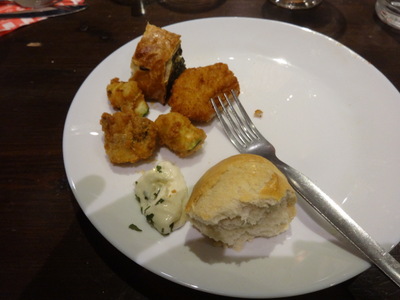 All the while, we were entertained by a violinist and accordionist (viewed here over David's shoulder) playing both local classics like Strauss waltzes and Hungarian rhapsodies and popular favorites like the theme from Dr. Zhivago and When the Saints Go Marching In.
All the while, we were entertained by a violinist and accordionist (viewed here over David's shoulder) playing both local classics like Strauss waltzes and Hungarian rhapsodies and popular favorites like the theme from Dr. Zhivago and When the Saints Go Marching In.
The third course was mixed fritters of various vegetables, with herb sauce.
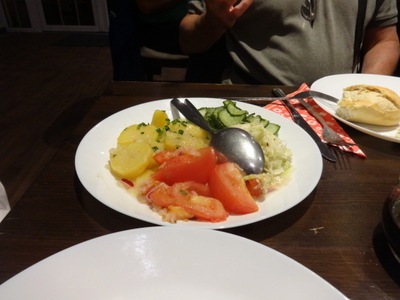
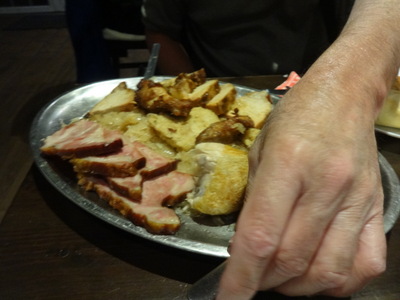 Then came platters of several vegetable salads—tomato and onion, cabbage with caraway, potato, and cucumber, and finally hot meat-filled pastries.
Then came platters of several vegetable salads—tomato and onion, cabbage with caraway, potato, and cucumber, and finally hot meat-filled pastries.
All that was apparently just appetizers, because the fifth course (shown here at the left) was platters arrayed with roast pork loin (in the back), braised smoked pork shoulder (in the front), seasoned roasted chicken pieces (over the top), slices of bread dumpling (sort of like cohesive stuffing, also over the top), all heaped over about a pound of excellent wine-braised sauerkraut!
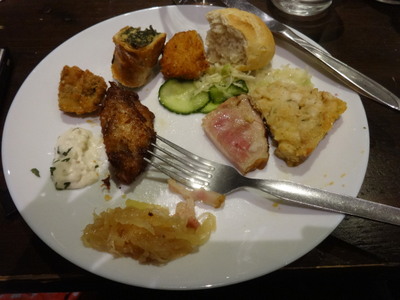
 DD
At the left here is my plate, with remnants of several courses. I tried to take just a little of everything, but it still added up to a whole lotta food!
DD
At the left here is my plate, with remnants of several courses. I tried to take just a little of everything, but it still added up to a whole lotta food!
Finally came dessert: Whole apricots and prune plums, pits and all, dipped in batter, deep fried, sprinkled with powdered sugar, and served with a sauce of stewed plums. A great idea in theory, but in fact, cooking stone fruit without added sugar makes it sour as all get out, and the little sprinkling of sugar wasn't enough. Even after they cooled enough that you could get close to them, I couldn't eat a whole one—just too sour.
Partway through dinner, another Viking party arrived, were seated at a different group of tables, and got a wine tasting with just munchies. Aha!, I thought. This explains a complaint I saw on Facebook's Viking forum. Someone complained that they signed up for a Heurigen evening and got just munchies, whereas they had attended Heurigen dinners elsewhere and had always gotten a full dinner. It seems Viking offers two different excursions, on different cruises that pass through the area—a "Heurigen dinner," which is what we got, and a "Heurigen evening," which gets just the wines, some munchies to go with them, and the music.
Then back to the buses for the trip to the ship, but of course, the Viking information-firehose never stops: